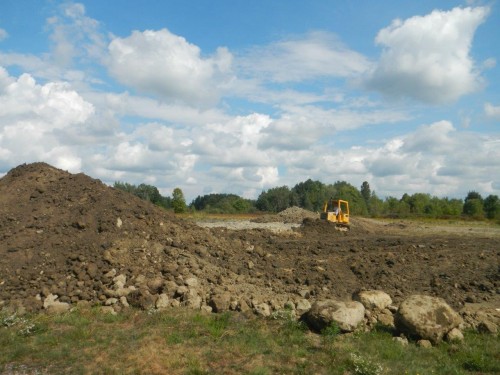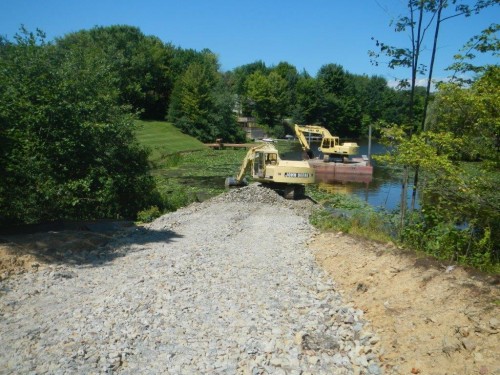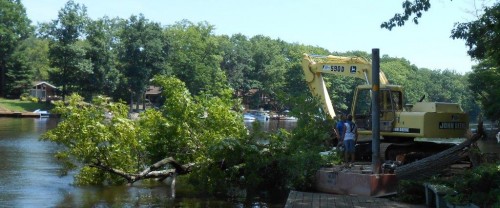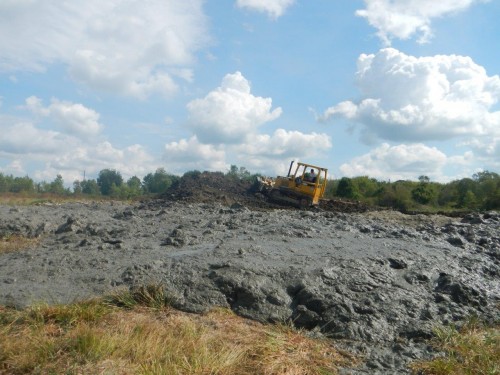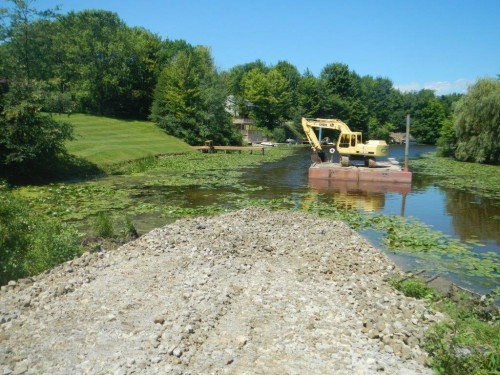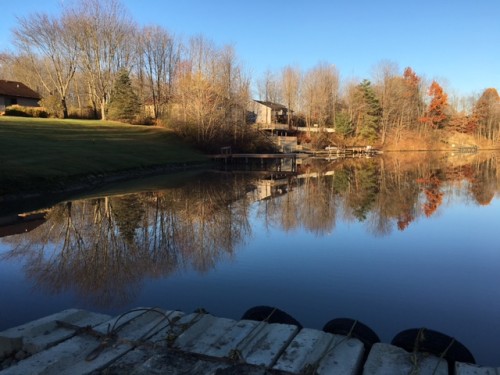Spiders – Creepy, Crawly and Lake Friendly
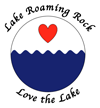 By Tim Langer – Lake Management Committee
By Tim Langer – Lake Management Committee
Summer is upon us and those eight-legged creatures quickly found your house, dock and boat. Now what? Well the answer isn’t always easy. Spiders are very beneficial as they consume many other insects and an important component of the ecosystem. But having cobwebs and spider droppings all over your house, dock and boat can be unsightly. Brushing the cobwebs off and washing your boat and dock frequently with fresh water (yep water alone) is one of the easiest and most lake friendly ways of control.
Pest control products for around your home typically use one of the following active ingredients, Bifenthrin – Ortho home Defense MAX, Gamma-Cyhalothrin – Spectracide Bug Stop, Cyfluthrin – Bayer Home Pest and there are many others. They work well around your home but are extremely toxic to fish and aquatic organisms and should never be used on your dock or boat near the water. Remember to always read the product label for application guidelines and precautions.
So what are we to do? Here are a few tips and tricks… Did you know, spiders smell and taste with their feet? So a home mixture of some essential oils sprayed on a surface will kill or deter spiders. Some of the essential oils to use are lavender, citronella, peppermint, tea tree oil, thyme and rosemary. You’ll be controlling spiders and adding fragrance to your home all at the same time. Be aware, you may have to apply this type of all natural control method more often to remain effective.
If you’ve tried the at home methods and a commercial product is what you are looking for then here a few alternatives. As times have changed so has the products available to consumers. Here are a few commercial products made with essential oils, making them completely eco-friendly, safe for your guests, your pets, children, and our environment. They are Essentria® IC3, EcoVia™ EC, Nature’s Element® Web Out® and Star brite® Spider Away. As with the home mixtures, you may need to apply more often since these are natural based products as compared to synthetic pesticides, but they are a much safer alternative for people, pets and the lake.
Remember to always spot test to ensure nothing happens to the surface you want to apply a product to and as always, remember to follow the product’s label.
We hope this article provides valuable insight into existing products and alternatives, which can help you, make informed choices for your own use and that of hired contractors.
BE LAKE RESPONSIBLE
… In The News
 By David Ernes – Lake Management Committee
By David Ernes – Lake Management Committee
In past articles, the Lake Management Committee has suggested the use of zero phosphorous fertilizers for lawn care. A recent article has indicated that other states take this suggestion very seriously. Case in point, in 2010, New York enacted the Dishwasher Detergent and Nutrient Runoff Law, which, as one of its provisions, prohibits the use of phosphorous-based fertilizers on lawns unless they are newly installed, or testing results show a low phosphorous content. One other interesting part of this law is that it restricts retailers in terms of how they can sell and display phosphorous-containing fertilizers. This recent article indicated that Lowes and Home Depot were fined $52,000 and $78,000 respectively for not properly labeling and segregating phosphorous containing fertilizers separately from non-phosphorous fertilizers. The article also indicated that Wal-Mart was also cited, but escaped fines by banning phosphorous fertilizers from their stores. This law was part of the state’s efforts to reduce the impact of phosphorous in runoff from lawns, which is said to have contributed to 70-100 lakes being impaired (i.e. negatively impacted for drinking or recreational purposes). Other states that have laws regarding the use of phosphorous fertilizers include NJ, MN, WI, MA and FLA.
Use of proper fertilizer applications can definitely impact the health of our lake. We therefore rely on those who do it themselves, as well as those that contract with a commercial service to use proper techniques and materials. Many states feel strongly enough about this to enact laws around this issue. But for us in Ohio, we rely on each of our residents to do their part to protect our lake. Do your part and help us all to…
BE LAKE RESPONSIBLE
Water Testing of Lake Roaming Rock
 By David Ernes – Lake Management Committee
By David Ernes – Lake Management Committee
We are definitely seeing signs that the winter has left us and we can begin to enjoy our lake for yet another fun-filled season of swimming, skiing and kayaking. This also marks the start of the Lake Management Committee’s (LMC’s) efforts to monitor the water quality to insure that it is safe for these activities. In past articles, we have discussed the issues related to algae blooms and the toxins that may sometimes be present. The LMC coordinates testing for these toxins to make sure that water at the two beaches is safe to enjoy. These two areas are where the greatest number of people swim at any one time. It should be noted that no result from the past three years has ever exceeded the guidelines set forth by the OhioEPA. We hope that this season will be the same. It should also be noted that many private lakes only test their beaches for bacteria, and not algal toxins. Should the levels of toxins or bacteria be exceeded, signs will be posted to warn of high levels.
This year we will be adding an additional type of testing. If you have used the many public beaches across the country, you may have encountered signs warning of bacteria contamination. This is based on testing for the presence of fecal coliforms, which are bacteria commonly found in the gut of most animals. Some, but not all, bacteria of this type can cause illness in humans. The LMC has decided to conduct testing for bacteria to insure that the levels are safe, again focusing on the two beaches. For bacteria, the results will be reported as “cfu/100 mL”. These units are strange and do not have any real correlation with concentration. For those geeks out there, the units represent “colony forming units per 100 milliliters of water”. A volume of 100 mL is roughly equivalent to a third of a cup. The current OhioEPA guideline for posting advisories for bacteria is 235 cfu/100 mL. This type of testing is routinely done for Ohio’s many public beaches. On the Ohio.gov web site, you can see the results from surrounding public beaches in their BeachGuard section.
If you see these signs, it will be your responsibility to decide if it is appropriate to swim in the water or to “take a day off” and use the pools. As with the toxins, those at the highest risk are the young and the “more mature” residents. In addition, since one potential source for bacteria is from run-off, the levels are often highest just after a significant rain event.
BE LAKE RESPONSIBLE
Want a Great Lawn?
 By Dick Hurwitz – Lake Management Committee
By Dick Hurwitz – Lake Management Committee
Many Roaming Shores residents take great pride in a beautiful lawn. This is a good thing! Not only does it add to the beauty of our village, but it also helps maintain or even increase the values of our properties. In some cases, however, a beautiful lawn may not be such a good things—if the beauty is a result of chemical applications that include nutrients which may be harmful to the health and safety of our lake. So if you would like a lawn that is, as much as possible, safe for the lake and beautiful as well, try some or all of these suggestions from the April 2016 issue of Reader’s Digest:
Wise Moves for a Lush Lawn
- Get tested. “Spending money on fertilizer without a soil test is just guessing,” says Paul Tukey. Good soil is key to a great lawn, and a soil test can tell you what’s in the dirt and what’s missing. For a test, call your county extension office (a national network of agriculture experts).
- Plant clover with your grass. Clover competes with weeds and fixes nitrogen in the soil. John Bochert, a lawn and garden specialist in York, Maine, recommends a seed mix of white clover, perennial rye (it germinates quickly), fescue, and bluegrass.
- Mow high, and leave the clippings. Taller grass provides more leaf for photosynthesis, develops deeper roots, and resists weeds. The clippings act as fertilizer. “Lawns mowed at four inches are the most weed-free,” Tukey says. “If you did only one thing, adjusting your mower height would be it.”
- Cut back on watering. Frequent watering leads to shallow roots, so “water once a week if at all,” says Tukey.
- Apply compost. “Weeds need light to grow,” Tukey says. “Spreading compost on a lawn in the spring prevents weed seeds from germinating.”
- Listen to weeds… “Weeds are nothing if not messengers,” says Tukey. “Dandelions are telling you the ground needs more calcium. Plantains are telling you the ground is too compact and needs aerating.”
- …and to insects. Beneficial nematodes, which are microscopic worms, eat some 200 species of insects, including grubs that become Japanese beetles; you can buy them from farm and garden stores. Mix them in water, and spray them on your lawn.
-Edgar Allen Beem
from Down East
What to Doo about Pet Waste
 By David Ernes – Lake Management Committee
By David Ernes – Lake Management Committee
One of the actions we can do to protect our lake is pick up after our dogs. Some estimates have an average dog generating ¾ of a pound of waste per day, or 270 pounds per year. Studies also indicate that only 60% of pet owners pick up their pet’s waste. The EPA has indicated 2-3 days of waste from 100 dogs could generate enough pollution (nitrogen, phosphorous and bacteria such as E. Coli) to close a beach, and affect the watershed for 20 miles.
In researching this article, I found some interesting facts. Most pet owners know that if the waste is left on the lawn, it will not fertilize but will kill the grass. It is also estimated that dog waste can take up to one year to completely breakdown. The natural ecosystem can only process and absorb the waste from two average dogs per square mile. If the ecosystem cannot absorb the waste fast enough, the bacteria and nutrients will be carried by rain into the watershed, and ultimately any body of water nearby (like our lake).
What can you do? The most common option is to pick it up with a plastic bag (like a grocery bag) and throw into the trash. There are biodegradable bags available, but I found pros and cons to this approach. A “green” option is composting. Here again, use proper methods because the compost bin must generate enough heat to destroy the bacteria present in the waste. It is recommended the composted pet waste not be applied to plants that will be eaten or be brought in to the home for decoration.
So if we “doo” the right thing, we can help reduce another controllable source of pollution to our lake. But don’t forget, a barking dog is a good deterrent for the Canadian geese that are also part of the problem.
BE LAKE RESPONSIBLE
Spring Cleaning (Lake-Responsible Style)
 By Dick Hurwitz – Lake Management Committee
By Dick Hurwitz – Lake Management Committee
Alright, so you’re looking out your window at the snow and cold and wondering when spring is going to come again to Roaming Shores. Then—just maybe—you start thinking about all the cleanup chores associated with spring and you think Maybe a little more snow and cold won’t be so bad. You soon remember, though, how good you feel when your house and deck and dock are clean, and how proud you are when you hit the water with a shiny boat; and you actually start looking forward to some of those cleanup chores. This year, however, you also start thinking about our Roaming Shores’ Love the Lake campaign and ask yourself how you can make your spring cleanup as “green” and lake-friendly as possible. The purpose of this article is to provide some answers to that question, to recommend some eco-friendly products, and to let you know where you can get more detailed product information. So get comfortable, take another quick look at the snow and cold, dream again of spring, and read on.
Powerwashing
There are a lot of cleaning products recommended for use with the powerwashers we use to clean our houses, decks, docks, watercraft, outdoor furniture, and probably other things as well. A number of them claim to be “eco-friendly” or “environmentally safe.” However, the labels also include directions for what to do if the products are ingested or get in your eyes; and they recommend you do not use them where the water they are mixed with may run off into a pond or lake. In this case, the safe thing to do is use the powerwasher without any additional cleaning products. Water alone, under the proper pressure and with the proper nozzle setting, should do a fine job.
General Cleaning
Look for products that are biodegradable, plant based, and free of phosphates, chlorine, and petroleum distillates to clean your outdoor things. (It is probably a good idea to use them inside too!) The following are a few recommendations:
- Bon Ami Liquid Cleanser
- Mrs. Meyer’s Clean Day Glass Cleaner
- Method Floor + Surface Cleaner
- Bill by Eco-Me All-Purpose Cleaner
- BOULDER® Citrus All-Purpose Cleaner
- Sun & Earth All Purpose
- Green Works Natural All-Purpose Cleaner
- Simple Green All-Purpose Cleaner
- Advantage 20X Cleaner – all natural multi-purpose cleaner
For more information on these products, refer to the Lake Management link on the Rome Rock Association website “Recommended Cleaning Products.”
Boat Cleaners
The following products are recommended for marine cleaning in a lake-responsible way:
- EcoDiscoveries All-Purpose Boat Wash (removes dirt, salt, and stains from boats)
- EcoDiscoveries Boat Seat Cleaner
- M2 from EcoDiscoveries (for mold and mildew)
- EcoDiscoveries Marine All-Purpose Boat Cleaner (designed to cut through grease, stains and other soils)
- Spray Nine All Purpose Cleaner (for removing mildew or stains, preventing mildew, removing black streaks or marks from fiberglass and vinyl boat seats)
Simple Green Marine All Purpose Boat Cleaner (multiple uses) - West Marine Pure Oceans Crystal Boat Soap (for cleaning all marine surfaces)
- West Marine Pure Oceans Hull Cleaner
- West Marine Pure Oceans Nanotec Fiberglass Cleaner Wax
- West Marine Pure Oceans Aluminum Pontoon Cleaner
- West Marine Pure Oceans Citrus Bilge Cleaner
- West Marine Pure Oceans Non Skid Deck Cleaner
Additional information on most of these products can also be found on the Association website.
Now it is up to you. Make the decision to follow the recommendations in this article when you are planning and doing your spring cleaning.
Decide to BE LAKE RESPONSIBLE
2015 Dredge Operation Summary
By: Dan Mullins
RRA Operations Manager
Operation for the season began April 16th, the day after the road weight limit ban ended. Our first task was to prepare the dewatering site which involved stock piling the material from 2014 to make room for the incoming material from 2015. This task was incorporated into the regular duties of the maintenance department along with the spring clean up from the previous winter, roadside clean up’s, downed tree limbs and pot-hole repairs, both pools had to be opened, beach clean ups, buoys installed on the lake, volley ball and tennis courts all had to be ready before Memorial Day, the start of the summer season. These tasks continued through April and May. During this time period, one of our full-time employees went out on a medical leave for most of the 2015 dredge & summer season. This loss of 25% of our manpower was a big setback, but adjustments were made and we moved forward.
The staging area at Fishermans Cove was installed, pictured below, and the work at our dewatering site continued. This staging area was a challenge due to the heavy amount of silt in this cove. The barges were launched and the dredge crew finished a channel at the end of Plum Creek removing 90 yards from this cove. The dredge crew then moved to the small, unnamed cove, on the northeast side of the lake. This cove was cleaned out removing 150 yards of material to assist with road drainage on Morningstar. The dredge crew then headed to Fishermans Cove. On the way towards Fishermans Cove, a call came into the office that a very large tree had fallen into the lake at the mouth of Plum Creek. The maintenance crew was able to utilize the excavator and barges to remove this very large oak tree from the water. The dredging platform made this task safer and decreased the amount of time it usually would take to remove this type of obstacle. Prior to having the dredge platform to work from in the water, tree’s this size would take on average 2 to 3 days cutting pieces small enough to handle safely from a boat to remove. The tree in the below photo took 3 hours to remove from the lake. This versatility allows us to remove these types of obstacles from the lake in a safer and more efficient manner.
Material being removed from the lake moved into high gear on June 17th. The access to Fishermans Cove was finished and the dredge crew, in between keeping all of the other summer amenities maintained, began dredging. For the month of June, 8 days were spent on the water dredging and 550 yards of material was removed from Fishermans Cove.
July was a busy month with the Fourth of July Fireworks and all of the other summer activities going on. Maintenance of the dewatering site, and access drives continued daily, pictured below. Another large tree was removed from Island Cove. The barge platform again made this task safer and allowed us to return to dredging the next day to Fishermans Cove. Along with their regular summer duties, the dredge crew spent 11 days on the water and removed 550 yards of material from Fisherman’s Cove.
The month of August was the end for all but 2 part time summer employees. This kept the full-time crew focusing on amenities and the winding down of the summer season. The crew dredged on the water a total of 9 days for the month of August and removed 550 yards of additional material from Fisherman’s Cove.
With the pools closing in September and the slowing of the need for grass mowing this allowed the dredge crew to remove 1,000 yards of material in Fishermans Cove in 10 days time. Our full-time employee returned to work on light duty, this had a positive impact on our production.
The month of October proved to be the most productive dredging month. This was due to manpower strictly focused on dredging. They were dredging daily for almost the entire month and removed an impressive 2,900 yards in 18 days. The weather was unusually dry and this allowed us to maintain our dewatering site easily in a month that is normally rainy and cold. Before and after pictures of Fishermans Cove below:
The barges were removed from the lake the last week of October before the lake draw down on November 2nd. There was the intention to continue dredging from the shore if the lake draw down was sufficient enough to allow this, unfortunately the cycle of drawn down did not allow us this opportunity.
Overview – The 2015 season total of removed material from the lake was 5,790 yards. We used 255 gallons of off road diesel and 193 gallons of on-road diesel. Our bulldozer consumed 65 gallons of off-road diesel for the season and our push-boat used 35 gallons of regular gas. We are very pleased with the performance of our equipment. We had no mechanical breakdowns in the 2015 dredge season. With this being our first full year incorporating the dredging operation along with the regular duties of the maintenance department, I am calling this season a great success!
Moving forward in 2016, the dredge crew continues to improve on the knowledge gained and improving the process. The dredging schedule for 2016 will be to finish Fishermans Cove, then move to Nature’s Cove and then onto Sugarcreek.
We are planning for another successful season in 2016!
Lake Management and the LMC
 By David Ernes – Lake Management Committee
By David Ernes – Lake Management Committee
What is lake management? You have no doubt heard that term used in many contexts. It has many definitions, from simple (the act of managing a lake!) to a very complex and wide-ranging series of activities. These can include the study of a watershed, evaluating problems experienced in a lake, remediation efforts and even social programs. The RomeRock Association Lake Management Group (LMC) is a Board sponsored group of unpaid volunteers that are devoting their time to further the enjoyment of our lake. It has evolved over the years.
In 2010, a Lake Management Report was prepared (7/9/2010) which included the selection of a professional consultant, in our case, EnviroScience, who continues to serve in that capacity today. In 2013, the LMC was divided into three sub-committees, each with a specific task. Of the three sub-committees, two sub-committees remain active today. They are the Lake Depth Control sub-committee who coordinates the dredging operation and this sub-committee the Lake Sediment/Nutrient Control. For simplicity, many of the communications from this sub-committee, like these articles, are now being issued under the banner of the LMC and the Love the Lake Logo. Past articles can be found under the Lake Management section of the RRA website.
Today, the activities of the LMC continue on several fronts. The most visible relates to education and outreach, primarily thru these articles to inform the residents of Roaming Shores. This effort is intended to give everyone information so that you can choose activities and practices that can control and possibly reduce the nutrients entering the lake. These nutrients are partially responsible for the occasional algal bloom, as well as other issues (clarity, etc.). Beyond education, we are monitoring the water quality through testing, identifying sources of nutrients from the watershed as well as investigating control methods such as rain gardens and buffer zones. We also monitor literature and other resources to keep current in the ongoing efforts and regulations within our state and elsewhere. If you would like to become part of our group, please contact us and bring your skills to assist your friends and neighbors to keep our lake something we can enjoy for years to come.
BE LAKE RESPONSIBLE
Where is that Spring Brochure?
 by Tim Langer – Lake Management Committee
by Tim Langer – Lake Management Committee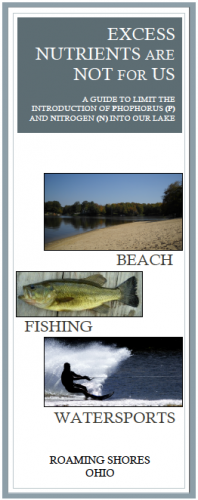
Did you know your Lake Management Committee previously published a spring brochure to help provide residents tips, tricks and best practices surrounding what each of us can do to help maintain and improve water quality of our community’s greatest resource, Lake Roaming Rock? If you are new to Roaming Shores or just misplaced your brochure, please stop by the Association or Village office to pick up a new one.
Remember to Love the Lake and BE LAKE RESPONSIBLE!
Protect Lake Erie, Even in the Winter
Even though Lake Erie may freeze during the winter, we need to continue to protect its waters. Many things we do around our homes and on our driveways in the winter time effects Lake Erie’s water quality, because whatever enters a storm drain or roadside ditch will eventually flow untreated to our rivers and end up in Lake Erie. Here are a few simple tips to follow this winter: 1. Don’t wait until spring rains wash all the winter gunk off your car; take it to a commercial carwash so that the salt residue, dirt, oil, grease, and break dust that built up on your car will drain to a sanitary sewer where the water can be treated. 2. Use salt wisely, because a little goes a long way – apply salt to driveways and sidewalks BEFORE it snows to help prevent ice buildup; shovel as much snow as possible, and then apply salt when necessary; if there is salt remaining on your sidewalk or driveway after the ice melts, sweep it up and save it for the next snow storm; try to pile salt on grassy areas, not over catch basins or near streams, to minimize the amount of accumulated pollution in the snow so when the snow melts, the grass will filter out the pollutants and won’t flow into waterways.
It may not seem like you alone can make a difference in cleaning up stormwater pollution, but think if everyone in your community did these simple steps and what an impact it would make. Do your part to love YOUR lake and help keep our stormwater clean.
This message was brought to you by the Lake County Stormwater Management Department.
